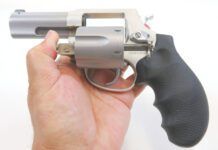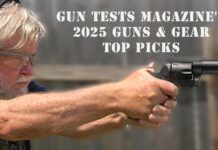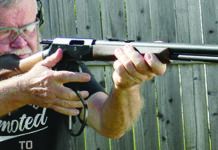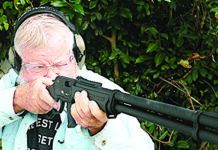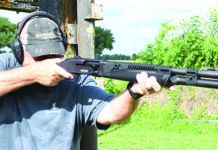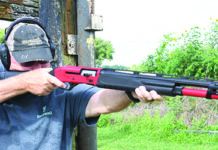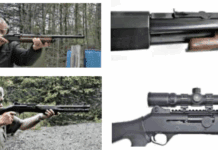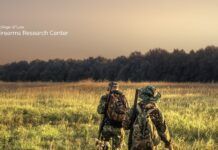In this evaluation, we will look at three .45 ACP 1911-style pistols. Not too long ago, this would mean three pistols that looked almost exactly alike. But today’s 1911 may contain as many different components as the total number of its parts. For example, the new Brownells catalog devoted solely to the 1911 lists as many as 27 different styles of custom hammers. Thus, our test guns offered several different variations on the 1911 platform.
Our three test guns were the $1421 Kimber Custom SIS RL, Springfield Armory’s $1332 Loaded Operator MC, and the $1129 Para Ordnance P14-45S GR. Each gun fired from a 5-inch barrel supported at the muzzle by a bushing and could be referred to as full-size “Government” models. But the Para Ordnance pistol offered higher capacity, feeding from a wider magazine wherein the rounds were piled in a zigzag pattern rather than stacked in a single column. All three guns varied in the designs of their grips, sights, and thumb safeties.
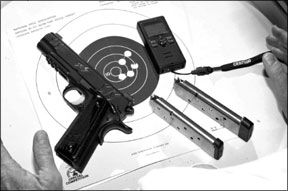
How We Tested
We began our tests firing five-shot groups with the shooter using a sandbag rest for support. Test distance was 25 yards, with blustery wind conditions. For ammunition we chose 185-grain Winchester Silvertip hollowpoints, and from Black Hills Ammunition the 200-grain lead semi-wadcutter loads plus 230-grain JHP ammunition. The 200-grain SWC loads were remanufactured, and the 230-grain JHP rounds were new manufacture.
We also devised a rapid-action test that we hoped would tell us more about the fast-handling capabilities of each pistol. At Phil Oxley’s Impact Zone range, we placed three steel practice targets 12 yards downrange and 8 feet apart. We chose these targets because the plates were durable and the stands rock solid, yet easy to fold and transport. The center target was a 10-inch rectangle, and the two outer targets were 8-inch circles. Each plate was mounted with a downward bias to deflect debris toward the ground. We used the Black Hills 200-grain semi-wadcutter ammunition for this test because of its popularity with the Practical Shooting crowd.
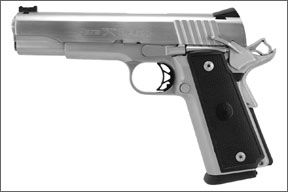
We began each run with the gun laying flat on a barrel top completely empty with the hammer down. Beside it, we put two loaded magazines. The shooter began with his hands along the rim of the barrel. Upon the audible start signal from a CED 7000 recording timer, our shooter grabbed one magazine and the gun, inserted the magazine, racked the slide and took aim at each target in rapid succession. After hitting each plate once, the shooter reloaded and reengaged the targets. This drill was repeated for a total of ten runs. We recorded the elapsed time, but of more interest was what transpired during each run. How did each gun help or hinder the shooter in getting the job done? Let’s find out.
Kimber SIS Custom RL .45 ACP, $1421
The Kimber SIS Custom RL had several distinctive features. Most notable were carving the initials “SIS” into the slide as cocking serrations front and rear. Striking fancy knurled wood grips adorned this pistol, and they accented the gun’s slick gray KimPro outer finish, which had an element of metal flake sheen. We did spy a small chip or wear through on the slide just above the slide stop pin on the right side.
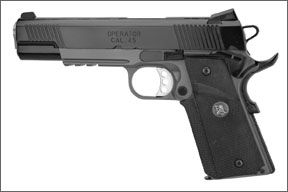
The SIS Custom RL came with night sights. The rear unit, windage adjustable via drift, was mounted in a dovetail aligning its rear face precisely with the back of the slide for maximum sight radius. Its forward edge presented a vertical surface reaching about 0.2 inches upwards from the top of the slide. This was to provide a catch point on one’s belt or other edge in case the slide needed to be racked without using two hands. Today’s pistols commonly feature a rear sight with a ramped profile front to back. The ramped profile is much less likely to snag clothing than a tall and sharp sight blade. But if the slide must be racked and the support hand is not available, the operator might wish for the sharp edge of the old-style rear sight. Kimber’s SIS-style rear sight meets this need without the worry of hanging up on the inside of a jacket or shirt.
The accessory rail front sight was a modern era feature, but the solid profile trigger (adjustable for over travel) gave the SIS a throwback look. The hammer was heavily serrated for grip, and its overall profile was modern, but the relief was small compared to our other pistols. Another custom touch was the 30-lpi checkering on the front strap. The mainspring housing showed deep vertical lines, and the raised surface of the grip safety was engraved with three wavy lines.
Thumb safeties were ambidextrous, with the right side being slightly reduced in contact area. A standard-length guide rod was in play, and the spring cap could be compressed by hand. Initially, we found the barrel bushing too tight to be turned without using a wrench, which was supplied. But by the fourth time we had broken the gun down, field stripping could be achieved completely by hand.
Elsewhere, the SIS represented a return to more traditional construction. First, the extractor was housed inside the slide. This not only protects the extractor but strengthens the slide. Furthermore, the suffix “II” was missing from the gun’s nomenclature, signifying that the Schwarz safety system was not part of the design. Type-II Kimber pistols contained a firing-pin lock that was released as the grip safety was compressed. We prefer non-Type II pistols because there is less chance of interference with the trigger press. At the bench we found that the trigger was consistent, letting off with the application of 5.25 pounds shot after shot.
In our accuracy tests the Kimber favored Winchester’s 185-grain Silvertip HP rounds. We measured a best overall group of 1.1 inches while producing 369 ft.-lbs. of muzzle energy. Only a single shot that ruined an otherwise tight group increased the average group size towards the 2-inch mark. Consistency was remarkable with all three test brands.
In our rapid-action tests, we learned much more about the Kimber SIS pistol. To start, we liked that the SIS arrived with three KimPro magazines that held eight rounds. Also, two base pads of different sizes were included, and they help seat the magazines during reloads. One set added approximately 0.3 inch to the overall length, and the other set added about 0.6 inch. These were rebuildable magazines, so they could be taken apart for cleaning, and the springs could be replaced when necessary.
In our first attempt at our rapid-action course of fire, our elapsed time was 9.79 seconds. We noticed the gun shot to point of aim, and the desired sight picture of a centered front sight with the top edges of the blade leveled within the notch was very easy to pick up. Our next run took only 9.02 seconds, and from then on elapsed times dropped below 9 seconds, with a best run of 8.14 seconds.
We thought the Kimber SIS Custom RL was the easiest of our three guns to point. Because the sights were precise and clear, we always knew when was the gun was lined up. The checkering was a big help, but we think matching the proper-width grip panels had a lot to do with finding the target and quickly loading the magazine. The Kimber’s magazine well did not appear to be extensively beveled, but we could find the proper angle for a smooth reload every time. What we didn’t like was the lack of grip supplied by the letters SIS on the slide. Combined with the slick finish (and whatever oil seeped out from beneath the slide), we were surprised every time we grabbed the slide that we were able to move it far enough to pick up a round. We think the only reason it worked every time is that the SIS was well tuned and willing to feed ammunition. Combined with a heavy recoil spring, this also made for a very uneasy feeling whenever we needed to pull back the slide to clear the chamber. Those seeking a quick fix may be happy to know that as slick as the Kimber KimPro finish was, we tried applying 3M grip tape and yes, it did stick. The jury is still out on the toughness of Kimber’s new finish.
In our estimation, the Kimber SIS Custom RL is just a few good cocking serrations away from being one of the best over-the-counter 1911s we’ve tried.
Springfield Armory Loaded Operator MC PX9105MLP .45 ACP, $1332
The Springfield Armory Loaded Operator MC is another example of old and new features brought together to create a combat handgun. The olive-drab frame contrasting with the black slide may not be new, but the texture and durability of its Armory Kote is a modern innovation. So is the accessory rail that formed the dust cover. Low-mount tritium night sights were in place along with other modern “custom” features such as a relieved hammer, ventilated aluminum trigger adjustable for overtravel, memory groove grip safety, checkered mainspring housing, and ambidextrous thumb safeties. The rubber Pachmayr grip panels that stretched a checkered rubber surface across the frontstrap was definitely a throwback feature. The magazine well was deeply beveled along the sides and also along the rear edge. Cocking serrations along the slide were not fancy, but they did cover about two-thirds of the area rearward of the ejection port and more than an inch of surface area behind the muzzle.
Springfield Armory 1911s feature an internal locking system that is key operated and effectively locks down the mainspring. The keyhole was barely noticeable just below the grip safety. Two seven-round magazines were supplied. We noticed that the amount of slide stop pin protruding from the right side was considerably less than on either the Para Ordnance or Kimber pistols. A low-profile or flush-fit slide stop is preferable because this helps prevent incidental contact from pushing it out of place and causing a stoppage.
From the 25-yard bench, all three rounds showed a consistent spread from smallest to largest group, but the Winchester 185-grain Silvertip HP rounds produced the best groups overall. The Springfield Armory pistol matched the Kimber with an average five-shot group measuring 1.9 inches across.
Firing from support and utilizing a controlled press, we thought the Pachmayr grip was a useful tool. It also performed much better than expected when our hands were wet. But in our rapid-action test we thought the rubber grip was holding us back. Indeed, our first run went very well. Elapsed time was only 8.19 seconds. But our next run took 10.49 seconds. Subsequent attempts bounced around from 8.5 to 9.9 seconds. The reason for the inconsistent times was easy to spot. The tacky feel and bulk of the grip required perfect technique every time. One wrong move in the sequence, and the gun would hang up in the shooter’s hand. We decided to change grips.
With a pair of Extreme Aluminum grips by Hogue in place, manipulation of the pistol was easier. Elapsed times dropped into a narrow range of 8.30 to 8.43 seconds. We also tested the Springfield pistol with Wilson’s dynamic new eight-round Elite Tactical magazines. Both the Springfield Armory and Kimber pistols ran without a single malfunction no matter which magazine was in place.
The Springfield Armory Loaded Operator MC was not as fancy as the Kimber SIS pistol. But aside from the grip panels, which were easily changed to fit the individual, some of its key features such as the cocking serrations were more efficient. Looking over our test results we were not able to quantify any disadvantage of the supplied sights, but at times we felt our vision was forced. A wider rear face that blocked more light would be our preference.
Overall, we think the Loaded Operator MC is a wise choice for home defense or the professional operator, but we narrowly prefer the Kimber.
Para Ordnance P14-45S GR .45 ACP, $1129
Para Ordnance is a Canada-based manufacturer that opened the door for the high-capacity 1911 pistol. The Para Ordnance catalog lists many high-capacity models, and even a good number of traditional single-stack pistols chambered for 9mm and .40 S&W as well as the big .45 with a variety of frame types and barrel lengths. Full-time double-action pistols are also available, but the subject of this test was the single action-only 14+1 capacity P14-45S GR. (The GR suffix stands for Gun Rights. Each sale of a GR pistol will prompt the manufacturer to donate money to the NRA-ILA legal defense initiative.)
The P14-45S GR differed from our other pistols by being necessarily wider in the grip. Overall width has been minimized by the application of very thin plastic grip panels held in place with stainless Allen screws. The grips were also distinguished by the way they were anchored using a tab seated into the frame. Choices of replacement grips were limited, but fancy wood panels are available from Navidrex and Hogue (see grips4guns.com). The P14-45S GR did not have an accessory rail. One alternative that worked for us was the Liberator by First Light. Suitable for left- or right-handed shooters, this high-powered flashlight slips over the hand with little interference to the normal shooting grip.
Another way in which our Para Ordnance pistol differed from our other test pistols was its full-length stainless-steel guide rod. Installing a full-length guide rod is one way to smooth cycling and increase the service life of the recoil spring. The addition of a full-length guide rod requires that the plug that retains the recoil spring be hollow so the rod can pass through as the gun cycles. The guide rod of the P14-45S GR was short enough to let the bushing pass over it without a problem. However, we do recommend the use of a wrench (supplied) to turn the bushing. This is because the end of the retainer can be tougher on the fingertips than the sealed cap found on the end of the short guide rod assemblies.
Visually, the Para Ordnance pistol had some nice touches. The theme of stainless steel and black gave it a very solid look. The checkered mainspring housing was black, and so was the trigger that was deeply skeletonized and adjustable for overtravel. The frame offered a matte finish, as did the top of the slide. The sides were brushed with cocking serrations found to the rear of the slide only. The front sight offered the shooter a rectangular outline to be centered inside the rear notch plus a red light-gathering filament to draw the eye. Spare lengths of red- and green-colored filament were supplied along with instructions for installation. The blade itself was seated into a narrow dovetail. But the base of the sight did not fill the cuts in the slide. In this way the front sight resembled a pinned unit. But checking beneath the slide, the front sight was indeed pressed into place. The rear sight was a ramp that ended with a serrated face and two white dots surrounding the notch. This unit was drift adjustable with an Allen set screw. Separate wrenches for the sight and the grip panels were supplied.
The visual profile of the rear sight was that of a semi-circle, and from the bench we found that aligning the sights required extra care—we did not find it easy to level the top of the front sight blade with the arc presented by the rear sight. Standard practice is to hold either dead center or level the sights at 6 o’clock below the bull. Our test shooter told us he was “cheating” by holding the sights to match the uppermost arc of the bull on our NRA B-16 target at the 12 o’clock position. Despite hitting the target some 4 inches low, the Para Ordnance was on par with its competitors, delivering on average a 2.0-inch five-shot group firing the Winchester Silvertips. Accuracy was just behind the Springfield Armory pistol firing the Black Hills semi-wadcutters, but on average this pistol handled the Black Hills 230-grain JHP rounds best overall. However, the difference in size between our smallest groups and our largest groups was extreme.
During our action tests we did experience three stoppages wherein the pistol did not fully return to battery. Normally, we would look first to the extractor. But the only real diagnostic action we took was to try shooting the five additional types of ammunition that we had on hand. These ranged from 230-grain FMJ rounds to 165-grain hollowpoints, and even some handloaded ammunition topped with lead truncated-cone bullets. But the problem did not appear again, leaving the problem unsolved. One result was that the Para Ordnance was shot much dirtier than our other test guns, but nevertheless completed the test without further malfunction.
Otherwise, the results of our action tests garnered three observations. First, the cocking serrations on the slide were handsome but not really effective, in our view. Like on the Kimber SIS, we were successful in charging the pistol each time, but it had us concerned every time we tried. Pulling back on the slide against the strong recoil spring was particularly unnerving when clearing the chamber. We feared the slide might slip from our hands before the round had fallen away. If this were to happen, the primer could be struck by the ejector with disastrous results. This is why we never like to see anyone cover the ejection port with a palm when clearing the chamber.
The second observation was that leveling the sights was something we could never be sure of. From shot to shot we just had to feel the gun into alignment. We’d take our cue from competitive shooters whose bread and butter is rapid sight acquisition and change the rear sight to a design that was flatter across the top.
The third observation was that it takes some practice to move the bigger, boxier grip frame in and out of position during a reload. But once we learned the correct reference points to manipulate the gun, the big hole at the bottom of the grip became an easy target for the magazine. Elapsed times were initially slowed by some clumsy attempts to bring the magazine release button to the thumb. The results were 10- and 11-second runs. Once our reloading technique was smoothed out, we recorded elapsed times consistently below 10 seconds. Our best single run took 8.84 seconds. While the other guns were knocking on the door of a 7-second run, we thought it was the difficult sight alignment that prevented us from completing the drill significantly faster than 9 seconds.
When it comes to high-capacity pistols with 1911-style controls, the guns of Para Ordnance are the only game in town without spending nearly twice as much. Still, we’d want improved sights, cocking serrations that actually help cock the pistol, and maybe some additional tuning before we’d buy the P14-45S GR ahead of the others.
0208-SPRINGFIELD-ARMORY-LOADED.pdf
0208-PARA-ORDNANCE-PX1445S.pdf




